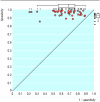Accuracy of Ottawa ankle rules to exclude fractures of the ankle and mid-foot: systematic review
- PMID: 12595378
- PMCID: PMC149439
- DOI: 10.1136/bmj.326.7386.417
Accuracy of Ottawa ankle rules to exclude fractures of the ankle and mid-foot: systematic review
Abstract
Objective: To summarise the evidence on accuracy of the Ottawa ankle rules, a decision aid for excluding fractures of the ankle and mid-foot.
Design: Systematic review.
Data sources: Electronic databases, reference lists of included studies, and experts.
Review methods: Data were extracted on the study population, the type of Ottawa ankle rules used, and methods. Sensitivities, but not specificities, were pooled using the bootstrap after inspection of the receiver operating characteristics plot. Negative likelihood ratios were pooled for several subgroups, correcting for four main methodological threats to validity.
Results: 32 studies met the inclusion criteria and 27 studies reporting on 15 581 patients were used for meta-analysis. The pooled negative likelihood ratios for the ankle and mid-foot were 0.08 (95% confidence interval 0.03 to 0.18) and 0.08 (0.03 to 0.20), respectively. The pooled negative likelihood ratio for both regions in children was 0.07 (0.03 to 0.18). Applying these ratios to a 15% prevalence of fracture gave a less than 1.4% probability of actual fracture in these subgroups.
Conclusions: Evidence supports the Ottawa ankle rules as an accurate instrument for excluding fractures of the ankle and mid-foot. The instrument has a sensitivity of almost 100% and a modest specificity, and its use should reduce the number of unnecessary radiographs by 30-40%.
Figures
Comment in
-
Ottawa ankle rules for the injured ankle.BMJ. 2003 Feb 22;326(7386):405-6. doi: 10.1136/bmj.326.7386.405. BMJ. 2003. PMID: 12595349 Free PMC article. No abstract available.
-
Ottawa ankle rules: sign may not be objective.BMJ. 2003 May 24;326(7399):1147; author reply 1147. doi: 10.1136/bmj.326.7399.1147-a. BMJ. 2003. PMID: 12764009 Free PMC article. No abstract available.
-
Clinical usefulness of the Ottawa Ankle Rules for detecting fractures of the ankle and midfoot.J Athl Train. 2010 Sep-Oct;45(5):480-2. doi: 10.4085/1062-6050-45.5.480. J Athl Train. 2010. PMID: 20831394 Free PMC article.
References
-
- Smith GF, Madlon-Kay DJ, Hunt V. Clinical evaluation of ankle inversion injuries in family practice offices. J Fam Pract. 1993;37:345–348. - PubMed
-
- Brand DA, Frazier WH, Kohlhepp WC, Shea KM, Hoefer AM, Ecker MD, et al. A protocol for selecting patients with injured extremities who need x-rays. N Engl J Med. 1982;306:333–339. - PubMed
Publication types
MeSH terms
LinkOut - more resources
Full Text Sources
Medical
Miscellaneous


